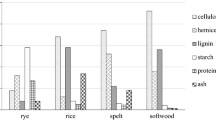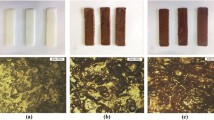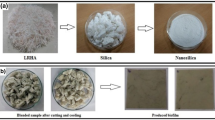Abstract
Natural seaweed microparticles obtained from Undaria pinnatifida waste (A) were used as fillers in thermoplastic starch (TPS)–chitosan (CH) blend in order to obtain microcomposites films for application in sustainable agriculture. The adequate proportion of both polymers was optimized with regards their mechanical, barrier, water interaction and morphological properties. Then, the effect of different content of seaweed on microcomposites properties was investigated. The seaweed used showed good interaction with the TPS–CH matrix. Its addition produced an increase in the tensile strength and a slight increase in the elongation at break. Contents of 10% of A lead to a more heterogeneous structure with the formation of aggregates. Low contents of A reduced the mobility of the polymer chains resulting in a lower moisture content and higher Tg, although the WVP increased with the content of A. The improvements achieved with microcomposites were finally discussed under the light of new agricultural mulch films regulations.








Similar content being viewed by others
References
Briassoulis D (2007) Analysis of the mechanical and degradation performances of optimised agricultural biodegradable films. Polym Degrad Stab 92:1115–1132. https://doi.org/10.1016/j.polymdegradstab.2007.01.024
Wortman SE, Kadoma I, Crandall MD (2015) Assessing the potential for spunbond, nonwoven biodegradable fabric as mulches for tomato and bell pepper crops. Sci Hortic (Amsterdam) 193:209–217. https://doi.org/10.1016/J.SCIENTA.2015.07.019
Pablo IA, Valiña A (2003) Cultivo bajo cubierta Zona sur de la provincia del Neuquén
Finkenstadt VL, Tisserat B (2010) Poly(lactic acid) and Osage orange wood fiber composites for agricultural mulch films. Ind Crops Prod 31:316–320. https://doi.org/10.1016/J.INDCROP.2009.11.012
Mitrus M (2010) TPS and its nature. Thermoplastic starch. Wiley-VCH Verlag GmbH & Co. KGaA, Weinheim, pp 77–104
Reis MO, Olivato JB, Bilck AP et al (2018) Biodegradable trays of thermoplastic starch/poly (lactic acid) coated with beeswax. Ind Crops Prod 112:481–487. https://doi.org/10.1016/J.INDCROP.2017.12.045
Carmona VB, Corrêa AC, Marconcini JM, Mattoso LHC (2015) Properties of a biodegradable ternary blend of thermoplastic starch (TPS), poly(ε-Caprolactone) (PCL) and poly(lactic acid) (PLA). J Polym Environ 23:83–89. https://doi.org/10.1007/s10924-014-0666-7
Akrami M, Ghasemi I, Azizi H et al (2016) A new approach in compatibilization of the poly(lactic acid)/thermoplastic starch (PLA/TPS) blends. Carbohydr Polym 144:254–262. https://doi.org/10.1016/J.CARBPOL.2016.02.035
Bonilla J, Talón E, Atarés L et al (2013) Effect of the incorporation of antioxidants on physicochemical and antioxidant properties of wheat starch–chitosan films. J Food Eng 118:271–278. https://doi.org/10.1016/J.JFOODENG.2013.04.008
Malerba M, Cerana R (2018) Recent advances of chitosan applications in plants. Polymers (Basel) 10:118. https://doi.org/10.3390/polym10020118
Xing K, Zhu X, Peng X, Qin S (2015) Chitosan antimicrobial and eliciting properties for pest control in agriculture: a review. Agron Sustain Dev 35:569–588. https://doi.org/10.1007/s13593-014-0252-3
Xoca-Orozco L-Á, Aguilera-Aguirre S, Vega-Arreguín J et al (2018) Activation of the phenylpropanoid biosynthesis pathway reveals a novel action mechanism of the elicitor effect of chitosan on avocado fruit epicarp. Food Res Int. https://doi.org/10.1016/J.FOODRES.2018.12.023
Singh A, Gairola K, Upadhyay V, Kumar J (2018) Chitosan: an elicitor and antimicrobial bio-resource in plant protection. Agric Rev 39:163–168
Merino D, Mansilla AY, Casalongué CA, Alvarez VA (2018) Preparation, characterization, and in vitro testing of nanoclay antimicrobial activities and elicitor capacity. J Agric Food Chem. https://doi.org/10.1021/acs.jafc.8b00049
Mansilla AY, Albertengo L, Rodríguez MS et al (2013) Evidence on antimicrobial properties and mode of action of a chitosan obtained from crustacean exoskeletons on Pseudomonas syringae pv. tomato DC3000. Appl Microbiol Biotechnol 97:6957–6966. https://doi.org/10.1007/s00253-013-4993-8
Terrile MC, Mansilla AY, Albertengo L et al (2015) Nitric-oxide-mediated cell death is triggered by chitosan in Fusarium eumartii spores. Pest Manag Sci 71:668–674. https://doi.org/10.1002/ps.3814
Pichyangkura R, Chadchawan S (2015) Biostimulant activity of chitosan in horticulture. Sci Hortic (Amsterdam) 196:49–65. https://doi.org/10.1016/j.scienta.2015.09.031
Rahman M, Mukta JA, Sabir AA et al (2018) Chitosan biopolymer promotes yield and stimulates accumulation of antioxidants in strawberry fruit. PLoS ONE 13:e0203769. https://doi.org/10.1371/journal.pone.0203769
Xu L, Geelen D (2018) Developing biostimulants from agro-food and industrial by-products. Front Plant Sci 9:1567. https://doi.org/10.3389/fpls.2018.01567
Battacharyya D, Babgohari MZ, Rathor P, Prithiviraj B (2015) Seaweed extracts as biostimulants in horticulture. Sci Hortic (Amsterdam) 196:39–48. https://doi.org/10.1016/J.SCIENTA.2015.09.012
Manivasagan P, Oh J (2016) Marine polysaccharide-based nanomaterials as a novel source of nanobiotechnological applications. Int J Biol Macromol 82:315–327. https://doi.org/10.1016/j.ijbiomac.2015.10.081
Bulota M, Budtova T (2015) PLA/algae composites: morphology and mechanical properties. Compos Part A Appl Sci Manuf 73:109–115. https://doi.org/10.1016/J.COMPOSITESA.2015.03.001
Chiellini E, Cinelli P, Ilieva VI, Martera M (2008) Biodegradable thermoplastic composites based on polyvinyl alcohol and algae. Biomacromolcules 9:1007–1013. https://doi.org/10.1021/bm701041e
Garrido T, Peñalba M, de la Caba K, Guerrero P (2016) Injection-manufactured biocomposites from extruded soy protein with algae waste as a filler. Compos Part B Eng 86:197–202. https://doi.org/10.1016/J.COMPOSITESB.2015.09.058
Torres S, Navia R, Campbell Murdy R et al (2015) Green composites from residual microalgae biomass and poly(butylene adipate-co-terephthalate): processing and plasticization. ACS Sustain Chem Eng 3:614–624. https://doi.org/10.1021/sc500753h
Jumaidin R, Sapuan SM, Jawaid M et al (2017) Effect of seaweed on mechanical, thermal, and biodegradation properties of thermoplastic sugar palm starch/agar composites. Int J Biol Macromol 99:265–273. https://doi.org/10.1016/j.ijbiomac.2017.02.092
Stawski D (2008) New determination method of amylose content in potato starch. Food Chem 110:777–781. https://doi.org/10.1016/j.foodchem.2008.03.009
De la Paz N, Pérez D, Fernández M et al (2013) Evaluación viscosimétrica del quitosano derivado de la quitina de langosta. Rev Iberoam Polímeros 14(2):84–91
Lavertu M, Xia Z, Serreqi AN et al (2003) A validated 1H NMR method for the determination of the degree of deacetylation of chitosan. J Pharm Biomed Anal 32:1149–1158. https://doi.org/10.1016/S0731-7085(03)00155-9
Balboa EM, Conde E, Moure A et al (2013) In vitro antioxidant properties of crude extracts and compounds from brown algae. Food Chem 138:1764–1785. https://doi.org/10.1016/J.FOODCHEM.2012.11.026
Britt K, Kangas P (2016) A preliminary assessment of dried algal biomass as a filler material in concrete. J Algal Biomass Util 7:147–152
American Society for Testing and Materials (2002) ASTM E96-00e1—Standard test methods for water vapor transmission of materials. ASTM, West Conshohocken, PA
Woggum T, Sirivongpaisal P, Wittaya T (2014) Properties and characteristics of dual-modified rice starch based biodegradable films. Int J Biol Macromol 67:490–502. https://doi.org/10.1016/J.IJBIOMAC.2014.03.029
ISO 9050:2003 (2003) Glass in building—determination of light transmittance, solar direct transmittance, total solar energy transmittance, ultraviolet transmittance and related glazing factors
Luchese CL, Pavoni JMF, dos Santos NZ et al (2018) Effect of chitosan addition on the properties of films prepared with corn and cassava starches. J Food Sci Technol 55:2963–2973. https://doi.org/10.1007/s13197-018-3214-y
Pelissari FM, Grossmann MVE, Yamashita F, Pineda EAG (2009) Antimicrobial, mechanical, and barrier properties of cassava starch–chitosan films incorporated with oregano essential oil. J Agric Food Chem 57:7499–7504. https://doi.org/10.1021/jf9002363
Bourtoom T (2008) Plasticizer effect on the properties of biodegradable blend film from rice starch-chitosan. Songklanakarin J Sci Technol 30:149–155
Ren L, Yan X, Zhou J et al (2017) Influence of chitosan concentration on mechanical and barrier properties of corn starch/chitosan films. Int J Biol Macromol 105:1636–1643. https://doi.org/10.1016/j.ijbiomac.2017.02.008
Mei J, Yuan Y, Wu Y, Li Y (2013) Characterization of edible starch–chitosan film and its application in the storage of Mongolian cheese. Int J Biol Macromol 57:17–21. https://doi.org/10.1016/J.IJBIOMAC.2013.03.003
Bourtoom T, Chinnan MS (2008) Preparation and properties of rice starch–chitosan blend biodegradable film. LWT Food Sci Technol 41:1633–1641. https://doi.org/10.1016/J.LWT.2007.10.014
Mollah MZI, Akter N, Quader FB et al (2016) Biodegradable colour polymeric film (starch-chitosan) development: characterization for packaging materials. Open J Org Polym Mater 06:11–24. https://doi.org/10.4236/ojopm.2016.61002
Mathew S, Brahmakumar M, Abraham TE (2006) Microstructural imaging and characterization of the mechanical, chemical, thermal, and swelling properties of starch–chitosan blend films. Biopolymers 82:176–187. https://doi.org/10.1002/bip.20480
Zhong Y, Song X, Li Y (2011) Antimicrobial, physical and mechanical properties of kudzu starch–chitosan composite films as a function of acid solvent types. Carbohydr Polym 84:335–342. https://doi.org/10.1016/J.CARBPOL.2010.11.041
Dang KM, Yoksan R (2016) Morphological characteristics and barrier properties of thermoplastic starch/chitosan blown film. Carbohydr Polym 150:40–47. https://doi.org/10.1016/J.CARBPOL.2016.04.113
Valencia-Sullca C, Vargas M, Atarés L, Chiralt A (2018) Thermoplastic cassava starch-chitosan bilayer films containing essential oils. Food Hydrocoll 75:107–115. https://doi.org/10.1016/J.FOODHYD.2017.09.008
Lozano-Navarro J, Díaz-Zavala N, Velasco-Santos C et al (2018) Chitosan-starch films with natural extracts: physical, chemical, morphological and thermal properties. Materials (Basel) 11:120. https://doi.org/10.3390/ma11010120
Gómez-Ordóñez E, Rupérez P (2011) FTIR-ATR spectroscopy as a tool for polysaccharide identification in edible brown and red seaweeds. Food Hydrocoll 25:1514–1520. https://doi.org/10.1016/J.FOODHYD.2011.02.009
Merino D, Gutierrez T, Alvarez VA (2019) Potential agricultural mulch films based on native and phosphorylated corn starch with and without surface functionalization with chitosan. J Polym Environ 27:97–105
Debandi MV, Bernal C, Francois NJ (2016) Development of biodegradable films based on chitosan/glycerol blends suitable for biomedical applications. J Tissue Sci Eng 7:1–9
Aouada FA, Mattoso LHC, Longo E (2011) New strategies in the preparation of exfoliated thermoplastic starch–montmorillonite nanocomposites. Ind Crops Prod 34:1502–1508. https://doi.org/10.1016/j.indcrop.2011.05.003
Mendes JF, Paschoalin R, Carmona VB et al (2016) Biodegradable polymer blends based on corn starch and thermoplastic chitosan processed by extrusion. Carbohydr Polym 137:452–458. https://doi.org/10.1016/J.CARBPOL.2015.10.093
Yan C, Wang R, Wan J et al (2016) Cellulose/microalgae composite films prepared in ionic liquids. Algal Res 20:135–141. https://doi.org/10.1016/J.ALGAL.2016.09.024
Soares JP, Santos JE, Chierice GO, Cavalheiro ETG (2004) Thermal behavior of alginic acid and its sodium salt. Eclética Química 29:57–64. https://doi.org/10.1590/S0100-46702004000200009
Epure V, Griffon M, Pollet E, Avérous L (2011) Structure and properties of glycerol-plasticized chitosan obtained by mechanical kneading. Carbohydr Polym 83:947–952. https://doi.org/10.1016/J.CARBPOL.2010.09.003
Bof MJ, Bordagaray VC, Locaso DE, García MA (2015) Chitosan molecular weight effect on starch-composite film properties. Food Hydrocoll 51:281–294. https://doi.org/10.1016/J.FOODHYD.2015.05.018
Li Q, Zhou J, Zhang L (2009) Structure and properties of the nanocomposite films of chitosan reinforced with cellulose whiskers. J Polym Sci Part B Polym Phys 47:1069–1077. https://doi.org/10.1002/polb.21711
Chen L, Tang C, Ning N et al (2009) Preparation and properties of chitosan/lignin composite films. Chin J Polym Sci 27:739. https://doi.org/10.1142/S0256767909004448
Niazi MBK, Broekhuis AA (2015) Surface photo-crosslinking of plasticized thermoplastic starch films. Eur Polym J 64:229–243. https://doi.org/10.1016/j.eurpolymj.2015.01.027
Jumaidin R, Sapuan SM, Jawaid M et al (2016) Effect of seaweed on physical properties of thermoplastic sugar palm starch/agar composites. J Mech Eng Sci 10:2214–2225. https://doi.org/10.15282/jmes.10.3.2016.1.0207
Escamilla-García M, Reyes-Basurto A, García-Almendárez B et al (2017) Modified starch-chitosan edible films: physicochemical and mechanical characterization. Coatings 7:224. https://doi.org/10.3390/coatings7120224
Talón E, Trifkovic KT, Nedovic VA et al (2017) Antioxidant edible films based on chitosan and starch containing polyphenols from thyme extracts. Carbohydr Polym 157:1153–1161. https://doi.org/10.1016/J.CARBPOL.2016.10.080
Barghini A, Ivanova VI, Imam SH, Chiellini E (2010) Poly-(ε-caprolactone) (PCL) and poly(hydroxy-butyrate) (PHB) blends containing seaweed fibers: morphology and thermal-mechanical properties. J Polym Sci Part A Polym Chem 48:5282–5288. https://doi.org/10.1002/pola.24327
Iannace S, Nocilla G, Nicolais L (1999) Biocomposites based on sea algae fibers and biodegradable thermoplastic matrices. J Appl Polym Sci 73:583–592. https://doi.org/10.1002/(SICI)1097-4628(19990725)73:4%3c583:AID-APP14%3e3.0.CO;2-H
Kadam SU, Pankaj SK, Tiwari BK et al (2015) Development of biopolymer-based gelatin and casein films incorporating brown seaweed Ascophyllum nodosum extract. Food Packag Shelf Life 6:68–74. https://doi.org/10.1016/J.FPSL.2015.09.003
Rhim J-W (2011) Effect of clay contents on mechanical and water vapor barrier properties of agar-based nanocomposite films. Carbohydr Polym 86:691–699. https://doi.org/10.1016/J.CARBPOL.2011.05.010
Sartore L, Vox G, Schettini E (2013) Preparation and performance of novel biodegradable polymeric materials based on hydrolyzed proteins for agricultural application. J Polym Environ 21:718–725. https://doi.org/10.1007/s10924-013-0574-2
Robinson D, Brae B (1991) Developments in plastic structures and materials for horticultural crops. ASPAC, Food Fertil Technol Center
Vox G, Santagata G, Malinconico M et al (2013) Biodegradable films and spray coatings as eco-friendly alternative to petro-chemical derived mulching films. J Agric Eng. https://doi.org/10.4081/jae.2013.286
Wang HMD, Chen CC, Huynh P, Chang JS (2015) Exploring the potential of using algae in cosmetics. Bioresour Technol 184:355–362. https://doi.org/10.1016/j.biortech.2014.12.001
Sathasivam R, Radhakrishnan R, Hashem A, Abd_Allah EF (2017) Microalgae metabolites: a rich source for food and medicine. Saudi J Biol Sci 26:709–722. https://doi.org/10.1016/j.sjbs.2017.11.003
Venkatesan J, Lowe B, Anil S et al (2015) Seaweed polysaccharides and their potential biomedical applications. Starch/Staerke 67:381–390. https://doi.org/10.1002/star.201400127
Acknowledgements
The authors acknowledge the National Research Council (CONICET), National Agency for Scientific and Technical Promotion (ANPCyT) and the National University of Mar del Plata (UNMdP) for the financial support and to the Dr. Diego Navarro, for the determination of starch molecular weight.
Author information
Authors and Affiliations
Corresponding author
Ethics declarations
Conflict of interest
None.
Additional information
Publisher's Note
Springer Nature remains neutral with regard to jurisdictional claims in published maps and institutional affiliations.
Electronic supplementary material
Below is the link to the electronic supplementary material.
Rights and permissions
About this article
Cite this article
Merino, D., Alvarez, V.A. Green Microcomposites from Renewable Resources: Effect of Seaweed (Undaria pinnatifida) as Filler on Corn Starch–Chitosan Film Properties. J Polym Environ 28, 500–516 (2020). https://doi.org/10.1007/s10924-019-01622-9
Published:
Issue Date:
DOI: https://doi.org/10.1007/s10924-019-01622-9




